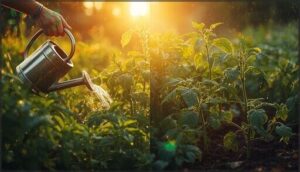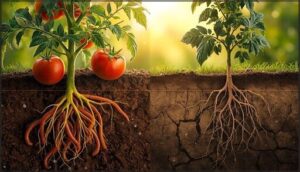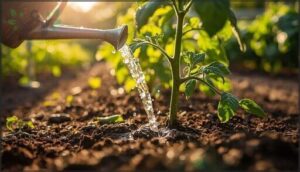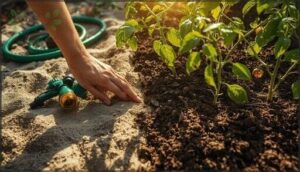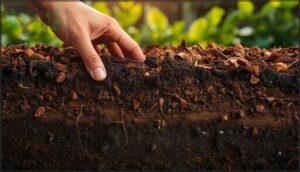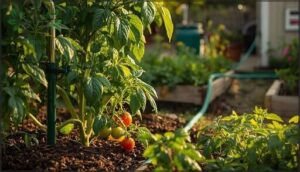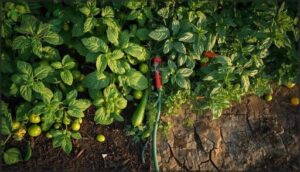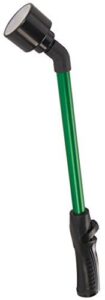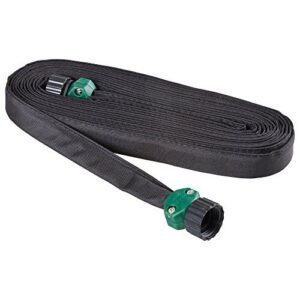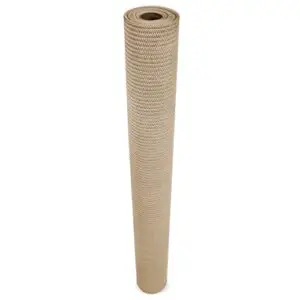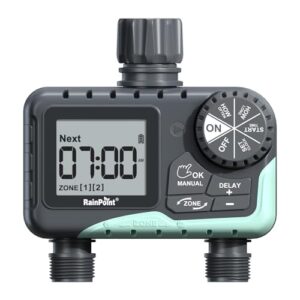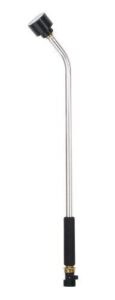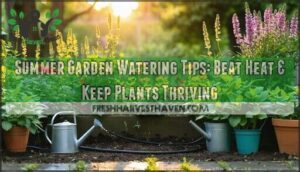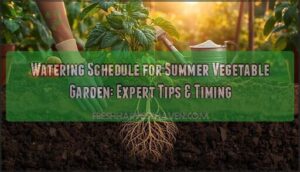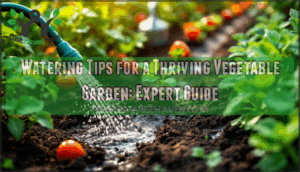This site is supported by our readers. We may earn a commission, at no cost to you, if you purchase through links.
Most summer gardens don’t fail from lack of water—they fail from watering done wrong. You might run your sprinkler every evening, watch puddles form around your tomatoes, and still see plants wilt by noon. The difference between a thriving garden and a struggling one often comes down to technique, not volume.
Sandy soil drains in hours while clay holds moisture for days, yet many gardeners water everything on the same schedule. Understanding how to water summer garden effectively means matching your methods to your soil type, plant needs, and local climate conditions.
With the right approach, you can cut water consumption by half while actually improving plant health and drought resistance.
Table Of Contents
- Key Takeaways
- Assessing Your Summer Garden’s Water Needs
- Choosing The Best Summer Watering Times
- Efficient Watering Techniques for Hot Weather
- Improving Soil for Maximum Moisture Retention
- Using Mulch and Shade to Reduce Evaporation
- Water Conservation Strategies for Summer Gardens
- Watering Container and Raised Bed Gardens
- Avoiding Common Summer Watering Mistakes
- Top 5 Tools for Effective Summer Watering
- Frequently Asked Questions (FAQs)
- Why should you water your garden during summer?
- How do you maintain a healthy garden during the summer?
- How often should you water your garden in summer?
- How do I Keep my plants hydrated during summer?
- How do I make my garden grow faster?
- How do I protect my plants from summer heat?
- How often should you water your garden in the summer?
- Is it better to overwater or underwater garden?
- Is it best to water a garden morning or night?
- What is the most efficient way to water a garden?
- Conclusion
Key Takeaways
- Most summer gardens fail not from lack of water but from poor watering technique—matching your method to soil type, plant needs, and climate can cut water consumption by half while improving plant health and drought resistance.
- Deep watering early in the morning builds drought-resistant root systems by encouraging roots to extend 8+ inches deep, reduces evaporation by up to 30%, and minimizes fungal disease risk by 60% compared to midday or evening watering.
- Soil amendments like organic compost can boost moisture retention by 37% in sandy loam (compost holds 20 times its weight in water), while a 2-4 inch mulch layer cuts soil evaporation by 60% and extends time between waterings.
- Drip irrigation and soaker hoses deliver water directly to root zones at over 90% efficiency—reducing water use by 30-50% compared to sprinklers—and combining them with rainwater harvesting can save up to 1,300 gallons per season.
Assessing Your Summer Garden’s Water Needs
Before you turn on the hose, you need to understand what your garden actually requires. Not every plant or patch of soil needs the same amount of water, and treating your entire garden the same way leads to waste and stressed plants.
Let’s walk through the key factors that determine how much water your summer garden truly needs.
Identifying Drought-prone Areas
Across your garden, look for visual indicators like wilting leaves, leaf scorch along exposed edges, and yellowing foliage—these signal drought-prone gardens where water stress hits hardest. Evaluating garden drought risk means understanding soil types: sandy areas drain fast, while clay retains moisture longer.
Climate factors like low humidity, strong winds, and intense sunlight create microclimates with higher evaporation. You can achieve beautiful gardens even by focusing on drought-resistant plant choices.
Check plant response and soil assessment weekly to pinpoint vulnerable zones before economic impacts reduce yields.
Evaluating Soil Type and Drainage
Understanding soil types shapes your watering strategy. Squeeze moist soil: if it forms a ribbon longer than 1 inch when pressed between your fingers, you’re dealing with clay that holds water but drains slowly at 1 to 5 millimeters per hour. Sandy texture crumbles easily and drains rapidly—often 30 millimeters per hour or more—requiring frequent irrigation.
Improving soil structure with organic matter balances infiltration rates and water-holding capacity. Adding organic matter helps to decrease soil density.
Monitoring Sun Exposure and Heat Levels
Soil drainage matters, but so does tracking summer heat. Place a soil thermometer 2 to 4 inches deep where plants struggle—surfaces above 85°F (29°C) signal heat stress and spike transpiration rates by 15 percent or more. Map microclimates by noting which beds bake in afternoon sun versus morning shade.
These three steps sharpen your heatwave response:
- Record daily soil temperatures at peak hours to identify zones needing shade cloth.
- Observe wilting patterns that reveal where sun protection falls short.
- Track air temperatures during extreme heat to time irrigation for minimal evaporation.
Recognizing Plant Water Requirements
Beyond heat zones, you must decode each plant’s water signals. Drought-tolerant succulents thrive at 20–40 percent of field capacity, while moisture-loving perennials demand 40–60 percent. Spot underwatering by crispy brown leaf edges; overwatering shows as yellow leaves and soft, limp foliage despite wet soil.
Track wilting patterns and match irrigation to these thresholds:
| Plant Type | Weekly Water Need |
|---|---|
| Drought-tolerant ornamentals | 20–40% field capacity |
| Moisture-loving perennials | 40–60% field capacity |
| Summer vegetables (early) | 20–25 mm |
| Summer vegetables (mid-season) | 40–50 mm |
Measure soil moisture 2–4 inches down—sandy soils reach stress near 20 percent volumetric water, clay around 40 percent. Quantitative watering cues prevent both plant stress and root rot.
Choosing The Best Summer Watering Times
Timing your watering can make the difference between a thriving garden and one that’s barely hanging on. When you water matters just as much as how much you water, especially during the hottest months.
Let’s look at the best times to water and what happens when you get it wrong.
Benefits of Early Morning Watering
Watering in the morning delivers multiple advantages for your summer garden. Early irrigation minimizes evaporation by up to 30%, ensuring water reaches roots efficiently. Root activity peaks at dawn, boosting absorption rates by 40%.
This timing also enhances heat tolerance throughout summer temperatures while reducing fungal disease risk by 60% as foliage dries quickly.
These watering techniques achieve significant water savings—often 25% compared to other schedules.
Risks of Midday and Evening Watering
While watering at the right time is essential, choosing midday or evening hours introduces serious watering mistakes. Midday evaporation wastes up to 50% of water before it reaches roots, while leaf scorch risk increases by 20% in heat-stressed plants.
Evening fungi pose equal danger:
- Wet foliage overnight raises powdery mildew by 70%
- Bacterial leaf spot increases 50% from prolonged dampness
- Cool temperatures reduce root uptake by 25%
- Fungal diseases spread 30% more in humid conditions
- Water waste climbs through inefficient nighttime absorption
These watering techniques greatly harm garden health.
Adjusting Schedules for Heatwaves
When temperatures soar above 90°F, evapotranspiration rates spike 18–38%, forcing you to rethink your summer watering schedule. Heatwave irrigation demands frequency changes that protect plant health while conserving water.
Monitor soil moisture closely—surface layers dry within hours during extreme heat, requiring watering techniques that deliver water before evapotranspiration rates steal it away.
| Plant Stage | Frequency Changes |
|---|---|
| Vegetable gardens | Daily or every-other-day |
| Container plants | Twice daily above 85°F |
| Established perennials | 1–2 deep soakings weekly |
| Lawns | More frequent deep watering |
Efficient Watering Techniques for Hot Weather
When temperatures soar, you need watering methods that work with the heat, not against it. The right approach helps your plants absorb moisture efficiently while reducing water loss to evaporation.
Here are four practical techniques that make a measurable difference in hot weather conditions.
Deep Watering Vs. Shallow Watering
The watering frequency you choose shapes your garden’s future. Deep watering encourages root systems to extend 8 inches or more into the soil, building drought resistance and stronger plants. Shallow watering keeps roots near the surface, making them vulnerable to heat stress.
Deep watering also improves water efficiency by reducing evaporation and fosters soil health through better nutrient movement and microbial activity.
Watering at The Base of Plants
Directing water to the root zone is one of the most effective summer watering techniques you can master. Here’s why it works:
- Reduces evaporation by up to 60% compared to overhead sprinklers
- Minimizes fungal diseases by keeping foliage dry
- Encourages deeper root growth for drought resistance
- Improves moisture retention and water conservation
Focus your watering at the base for healthier plants.
Grouping Plants by Similar Water Needs
Hydrozoning organizes your garden by plant compatibility and water requirements, cutting consumption by 20-50% through smart garden design. This plant selection strategy simplifies watering plants while maintaining ideal soil moisture. You’ll conserve resources and reduce maintenance needs through efficient hydrozone design that matches each zone’s water efficiency requirements.
Group high-water crops like celery together, separate from drought-tolerant waterwise plants like rosemary that use only 12-20 inches annually.
Watering Frequency and Duration Tips
Once you’ve grouped plants correctly, watering frequency depends on your soil type. Sandy soils need watering twice weekly at about half an inch per session, while established beds thrive on deep watering every 3-4 days.
Check soil moisture by inserting your finger to the first knuckle—adjust duration based on what you find below the surface to prevent stress and encourage deep root growth.
Improving Soil for Maximum Moisture Retention
Your soil is the foundation of your garden’s water efficiency. If it can’t hold moisture, no amount of watering will keep your plants from drying out.
Two practical soil improvements will help you retain more water where your plants need it most.
Adding Organic Compost or Aged Manure
You can dramatically improve your soil’s water retention by working organic compost or aged manure into the root zone. Increasing organic matter from 1% to 3% in sandy loam boosts moisture retention by 37%, which translates to real irrigation reduction benefits—often cutting summer watering demands in half.
- Compost holds 20 times its weight in water
- Aged manure enhances field capacity and moisture retention
- A 3-inch layer tilled into 6 inches raises capacity by 250%
These soil amendments extend drought tolerance gains by up to five days.
Avoiding Excessive Tilling
While organic amendments work wonders, avoid excessive tilling that causes soil structure damage and erosion control setbacks. Each tillage pass loses 0.5 to 0.75 inch of soil moisture through evaporation and disrupts water retention pathways you’ve just built.
No-till practices cut erosion by over 80% and boost infiltration rates up to four times higher—preserving organic matter, root health, and the summer watering efficiency your garden needs.
Using Mulch and Shade to Reduce Evaporation
Reducing evaporation is one of the most effective ways to keep your summer garden hydrated without constantly running the hose. Mulch acts as a protective barrier over the soil, while shade helps cool the air around your plants and slows moisture loss.
Here’s how to use both strategies to make every drop count.
Selecting The Right Organic Mulch
Not all organic mulch works the same way—your choice directly impacts water retention and soil health. Wood chips and bark mulch last multiple seasons, offering long-term moisture benefits and soil temperature regulation. Straw decomposes faster, enriching soil but needing frequent replacement. Leaf mold improves texture while keeping roots cool.
Each type provides pest suppression and different mulching benefits, so match your mulch to your garden’s specific needs.
Applying Mulch for Best Results
Once you’ve selected your organic mulch, apply a 2 to 4 inch layer around plants to cut soil evaporation by up to 60%. Mulch thickness matters more than mulch types for maximizing moisture retention—hemp bedding holds 80% of water, while bark retains just 16%.
Time your application in mid to late spring, then replenish throughout summer for soil moisture benefits and effective watering integration.
Using Shade Cloths and Companion Plants
Beyond mulch, combining shade cloths with companion plants creates powerful water conservation layering by moderating microclimates and regulating soil temperature. Aluminet materials cut heat by 15-22°F, while green covers improve water efficiency more than black or white alternatives.
- Install 50-70% shade cloth density over vulnerable beds to prolong irrigation intervals
- Plant marigolds at soil level for natural shade and reduced evaporation
- Use legumes alongside heavy feeders to boost moisture retention through improved soil structure
- Combine physical and plant shade for companion plant synergy that stabilizes humidity
- Monitor root zone temperatures—strategic shading cuts water needs by up to 30% in summer garden care
Water Conservation Strategies for Summer Gardens
Smart water conservation isn’t about restricting your garden—it’s about working smarter, not harder. The right strategies can cut your water use by 30% to 50% while keeping plants healthier than ever.
Here are four proven techniques that deliver maximum results with minimal waste.
Installing Drip Irrigation or Soaker Hoses
Drip irrigation and soaker hoses are efficient irrigation systems that deliver water directly to root zones, reducing evaporation. Drip systems operate at 15-30 psi system pressure with emitter spacing matched to your soil—12 inches for sand, 18 for clay. Soaker hoses work best at 10 cm burial depth.
Both watering methods cut water use by 30-50% compared to sprinklers, though drip requires less maintenance needs. Retrofitting lawns means burying hoses 18 cm deep.
Recycling Plastic Bottles for Deep Watering
Recycle plastic bottles into a deep soak system that targets root zones while cutting costs. Poke 10-15 small holes in a 2-liter bottle’s bottom half, then bury it upside down 4 inches deep near your plants.
This watering technique delivers moisture over 10 hours, reduces consumption by 60%, and boosts yields up to 230%—proving you can water efficiently without expensive equipment.
This watering technique delivers moisture over 10 hours, reduces water use by 60%, and boosts yields up to 230% without expensive equipment
Harvesting and Using Rainwater
Harvesting rainwater for irrigation transforms roof runoff into a free resource that cuts municipal water use by up to 1,300 gallons per season. Here’s how to capture it safely:
- Install a 50–60 gallon barrel under downspouts—a 200-square-foot roof fills it with just half an inch of rain.
- Use drip or soaker systems to keep water off edible leaves, reducing pathogen risks.
- Size storage capacity to match your climate; wetter regions need smaller tanks than arid zones for reliable supply.
Preventing Water Waste and Runoff
Converting from overhead spray to efficient irrigation systems like drip lines cuts water waste by up to 50% while preventing runoff. Smart garden layout matters too: create shallow basins in beds to capture overspray before it becomes runoff, maximizing every drop through strategic water conservation.
You’ll see the biggest gains by improving soil infiltration—incorporate compost to quadruple absorption rates—and applying 2–4 inches of mulch around plants.
Watering Container and Raised Bed Gardens
Container and raised bed gardens dry out faster than in-ground plots because they hold less soil and lose moisture through exposure on all sides. This means you’ll need to adjust your watering approach to keep plants healthy without drowning their roots.
The following strategies will help you maintain the right moisture balance throughout the summer.
Choosing Self-watering Pots
For summer watering in container gardening, self-watering pots simplify soil moisture management by reducing water usage up to 50% through efficient reservoirs. Design variations include water indicators that signal refill times, while size considerations suit everything from herbs to vegetables.
When choosing material choices, plastic models offer weather-resistant durability.
Pair pots with wicking-friendly potting mixes—peat moss blended with perlite performs best in hot conditions.
Adjusting Watering Frequency for Containers
Self-watering pots simplify care, but you must still adjust watering frequency for container plants based on temperature effects and sun exposure.
When daytime temperatures hit the 80s °F, most containers need water 3–4 times per week; in the 90s °F, daily irrigation becomes essential. Container size matters—smaller pots dry faster than large ones, sometimes requiring twice-daily moisture monitoring during heatwaves for best summer watering tips.
Preventing Overwatering and Root Rot
Even with careful watering frequency, overwatering remains the biggest threat to container health. Poor soil drainage traps moisture, starving roots of oxygen and inviting root rot pathogens—present in 27–34% of garden soils.
Watch for these overwatering signs to catch problems early:
- Yellowing leaves despite moist soil
- Wilting when the container feels heavy
- Mold or algae on the surface
- Foul odors from anaerobic conditions
- Leaf drop or edema blisters
Check drainage holes before each watering. If water pools on top or doesn’t drain within minutes, you’re risking fungal diseases. Let the top inch dry completely between waterings—this simple maintenance practice cuts root rot incidents by 60%. Sandy soil drains 2–3 times faster than clay, so adjust your schedule accordingly.
Avoiding Common Summer Watering Mistakes
Even experienced gardeners can fall into watering traps that stress plants or waste precious water during summer heat. You might be watering too much, too little, or at the wrong time without realizing the damage it’s causing.
Here’s how to spot and avoid the most common mistakes that can undermine your summer garden’s health.
Recognizing Signs of Overwatering and Underwatering
Your plants speak through visible symptoms, but decoding them matters. Overwatering creates soft, yellow leaves with brown spots, while soggy soil develops mold—up to 80% of plant death stems from excess water. Underwatering produces brittle, crispy edges and compacted soil. Check root health: mushy roots signal overwatering; stunted growth indicates drought stress.
| Indicator | Signs of Overwatering | Signs of Underwatering |
|---|---|---|
| Leaf Symptoms | Yellow leaves, brown spots with halos, soft wilting | Dry, crispy brown edges, brittle texture, leaf drop |
| Soil Indicators | Constantly wet, sour smell, mold growth | Hard, compacted, cracks, poor water penetration |
| Root Health | Mushy, rotting roots, suffocated by excess water | Stunted growth, reduced transpiration (3-23% decline) |
| Stress Types | Nutrient leaching, edema blisters on leaves | Visible wilting below 0.25 m³·m⁻³ substrate water |
Preventing Leaf Scorch and Fungal Diseases
When temperatures climb above 32–35 °C with low humidity, plant stress intensifies and leaf scorch risk doubles—yet overhead watering won’t burn foliage like myth suggests. The real threat? Prolonged leaf wetness lasting 7–12 hours invites fungal diseases like downy mildew.
Water at the base early morning to promote air circulation, maintain consistent soil moisture, and keep leaves dry—reducing disease outbreaks without fungicide dependency.
Regularly Checking Irrigation Systems for Leaks
Every month, inspect your watering system for hidden leaks—broken heads waste up to 25 gallons per minute, and system failures can spike bills by 20%.
Check these critical zones:
- Drip irrigation emitters and connections for clogs or splits
- Smart irrigation controllers for scheduling errors
- Valve boxes for trickling or pooling water
- Sprinkler heads for misdirected spray onto pavement
Early detection prevents massive water waste and protects efficient watering investments.
Top 5 Tools for Effective Summer Watering
The right tools make summer watering faster, more efficient, and less wasteful. Each option below has a specific purpose, from delivering water directly to roots to automating schedules during peak heat.
Choose based on your garden’s layout, your soil type, and how much time you can dedicate to daily maintenance.
1. Dramm One Touch Rain Wand Green
If you want to deliver a gentle, rain-like shower to your summer garden without disturbing soil or stressing plants, the Dramm One Touch Rain Wand combines effective watering techniques with smart water conservation.
Its aluminum construction and thumb control valve give you precise flow adjustment—from a trickle for seedlings to full pressure for thirsty beds—without squeezing a trigger until your hand cramps.
The 16-inch length reaches hanging baskets and deep beds easily, while the gentle watering pattern reduces runoff on sandy soils and protects delicate foliage during hot weather.
Best For: Gardeners who want gentle, full-flow watering with precise control and less hand fatigue during long summer sessions—especially if you’re dealing with delicate plants, hanging baskets, or mobility issues.
- Thumb-controlled valve gives you complete flow adjustment without constant trigger squeezing, so your hand won’t cramp during extended watering
- Gentle shower pattern delivers high volume without disturbing soil or splashing disease onto leaves, which matters in hot, humid weather
- Aluminum and metal construction with a lifetime guarantee means it actually lasts multiple seasons, unlike plastic wands that crack and leak
- Some users report the thumb valve can start leaking over time, particularly at connection points
- Needs decent water pressure to work well—if you’re on low pressure, the shower effect won’t be as effective
- A few customers mention durability issues with plastic components breaking within a year, despite the overall metal build
2. Melnor Flat Soaker Garden Hose 50ft
For raised beds and vegetable gardens demanding direct root watering, the Melnor Flat Soaker Garden Hose delivers moisture precisely where your plants need it most. Its flat, porous design eliminates the runoff common in overhead watering methods while boosting watering efficiency by reducing evaporation up to 70%.
When you’re finished, the vinyl construction flattens for compact storage in tight spaces. Connect multiple hoses together with the included rust-resistant end cap to expand coverage.
Just maintain pressure below 40 PSI—ideally 10 to 30 PSI—to guarantee even distribution and prevent leaks.
Best For: Gardeners with raised beds or vegetable patches who want efficient root-level watering without the hassle of overhead sprinklers or bulky hoses.
- Cuts water waste dramatically by delivering moisture directly to roots and reducing evaporation by up to 70%
- Flattens down for easy storage and weaves flexibly around plants without kinking
- Expands your coverage by connecting multiple hoses with the rust-resistant end cap
- Durability is hit-or-miss—some users report leaks or bursts within just a few months of use
- Needs low water pressure (10-30 PSI) to work properly, which limits where you can use it
- The full 50-foot length can create uneven watering in smaller gardens if you don’t need that much coverage
3. Coolaroo Wheat Shade Cloth Privacy Screen
When midday sun threatens your garden, the Coolaroo Wheat Shade Cloth Privacy Screen delivers UV protection and heat reduction that cut irrigation cycles. Its 90% UV block transforms the garden microclimate beneath—studies show shading lowers soil temperatures and evaporation losses, stretching moisture between watering techniques.
The breathable HDPE weave won’t trap heat like solid tarps. Installation methods include fastening to pergolas or overhead frames above heat-sensitive zones.
Though best suited for shade-loving ornamentals rather than sun-demanding vegetables, it’s a strategic summer watering tip for drought-prone corners needing relief.
Best For: Gardeners looking to protect shade-loving ornamentals and reduce water needs in high-heat areas, or homeowners needing privacy screening with cooling benefits for patios and pergolas.
- Blocks 90% of UV rays while staying breathable, cutting soil evaporation and stretching time between waterings in hot weather
- Built to last with fade-resistant, recyclable HDPE backed by a 15-year warranty against UV breakdown
- Versatile 6′ x 15′ size works for garden beds, pergolas, fences, or DIY projects like window shades
- Too dense for most vegetables—fruiting crops and leafy greens need 30–50% shade, not 90%, so you’ll need strategic placement
- Edges can arrive uneven or stiff, requiring trimming and extra hardware to hang cleanly
- Some customers report incorrect roll lengths or persistent wrinkles after installation
4. RAINPOINT Two Zone Water Timer
When two garden zones demand different watering schedules, the RAINPOINT Two Zone Water Timer’s dual-zone benefits simplify summer irrigation. Programming features let you set each outlet independently—cycle daily for full-sun beds, every third day for shade—while the automatic timer executes those watering techniques without manual intervention.
Its upgraded IP65 rating improves hardware durability against summer storms. Though not among sophisticated smart irrigation controllers, the large LED interface and rain-delay mode support practical water conservation, making it a reliable smart watering tool for busy gardeners managing varied watering schedules.
Best For: Gardeners managing two different zones with separate watering needs—like a sunny vegetable patch and a shaded flower bed—who want straightforward scheduling without a full smart-home setup.
- Two independent outlets mean you can water your tomatoes daily while giving your hostas a drink just twice a week, all from one faucet.
- The upgraded IP65 waterproof rating holds up better against summer downpours and sprinkler splash than older models.
- Rain-delay mode and flexible hourly or daily cycles help you cut water waste without babysitting the system.
- Some users report leaks at connections or durability hiccups, so check fittings regularly and keep it out of all-day sun if possible.
- It’s battery-powered (AAA cells), which means you’ll need to swap them out and watch for low-battery warnings mid-season.
- No true smart-home integration on the basic model—if you want app control and weather data, you’ll need to step up to RainPoint’s WiFi version.
5. Dramm Classic Rain Wand With Shutoff
The Dramm Classic Rain Wand With Shutoff extends your reach to hanging baskets and tall containers while its 400 PL breaker head delivers a gentle shower that won’t disturb soil or flatten foliage. Shutoff benefits include instant flow control between plants—press the thumb lever to halt waste as you reposition.
Aircraft-alloy construction ensures material durability through seasons of daily use, and user feedback confirms the wand maintains watering performance after five years. This watering wand promotes slow and deep watering at the base, refining watering techniques for efficient summer care.
Best For: Gardeners with hanging baskets, tall containers, or arthritic hands who need a lightweight wand that delivers gentle watering without disturbing plants.
- Lifetime guarantee with aircraft-alloy construction that holds up after years of daily use
- One-touch shutoff valve saves water by letting you stop flow instantly between plants
- Delivers up to 11 gallons per minute in a rain-like pattern that soaks roots without flattening foliage
- Price point feels high compared to basic wands
- May kink or underperform with expandable “pocket hoses”
- Requires decent water pressure to work properly
Frequently Asked Questions (FAQs)
Why should you water your garden during summer?
When the heat’s on, your garden can’t just weather the storm. Summer watering prevents plant stress, promotes growth, ensures disease resistance and yield, while protecting containers from drought stress through proper soil moisture and watering techniques.
How do you maintain a healthy garden during the summer?
You maintain a healthy summer garden by combining efficient watering techniques with soil moisture management. Deep watering promotes strong roots, while organic mulch conserves water and prevents evaporation, ensuring peak plant health throughout summer.
How often should you water your garden in summer?
You’d think summer watering schedules are simple, yet most in-ground gardens thrive on just one to three deep sessions weekly—not daily sprinkling—while containers demand attention once or twice daily during heat spells.
How do I Keep my plants hydrated during summer?
Keep your plants hydrated during summer by watering deeply at the base early each morning, applying 2–3 inches of organic mulch, and grouping plants by similar water needs to simplify consistent moisture management and boost heatwave survival.
How do I make my garden grow faster?
Your garden thrives when you combine smart soil nutrition with strategic feeding and microclimate adjustments. Deep watering practices encourage strong root growth, while organic mulch locks in soil moisture, supporting faster plant growth throughout summer gardening.
How do I protect my plants from summer heat?
Apply shade cloth rated at 30–50% light reduction over heat-stressed crops.
Water early in the morning to keep root zones cool.
Use 5–10 cm of organic mulch to lower soil temperatures and prevent wilting.
How often should you water your garden in the summer?
Your summer watering frequency depends on soil type and plant needs. Sandy soils need twice-weekly irrigation, while clay or loamy soils require once-per-week watering.
Most vegetables need 1 inch of water weekly during hot weather.
Is it better to overwater or underwater garden?
Underwatering is safer than overwatering because chronic saturation causes root rot, oxygen starvation, and higher mortality risks.
Brief drought stress recovers quickly, while prolonged overwatering creates irreversible physiological damage and fungal disease risks.
Is it best to water a garden morning or night?
Picture a tomato plant with wet leaves at sunset—by dawn, powdery mildew has taken hold.
Morning watering wins: you’ll cut disease risk and slash evaporation by 30%, ensuring healthier summer growth with smart timing.
What is the most efficient way to water a garden?
Drip irrigation delivers water directly to root zones at over 90% efficiency—far better than sprinklers.
Pair it with early morning watering and organic mulch to minimize evaporation and boost soil moisture retention.
Conclusion
Mastering moisture means matching method to matter—your soil, your plants, your climate. When you learn how to water your summer garden effectively, you’re not just preventing wilted leaves; you’re building drought-resistant root systems that thrive through August’s worst.
Deep watering at dawn, strategic mulching, and drip irrigation aren’t complicated—they’re the difference between maintenance and mastery.
Your garden’s resilience starts beneath the surface, where every intentional watering decision compounds into lasting strength.
- https://extension.colostate.edu/resource/drip-irrigation-for-home-gardens/
- https://structurelandscapes.com/how-to-save-water-with-a-summer-ready-irrigation-schedule-efficient-planning-for-hot-months-ahead/
- https://www.rainbird.com/professionals/irrigation-scheduling-use-et-save-water
- https://ipm.ucanr.edu/PMG/GARDEN/ENVIRON/evap.html
- https://blog-crop-news.extension.umn.edu/2025/07/a-look-at-crop-water-use-trends-and.html


